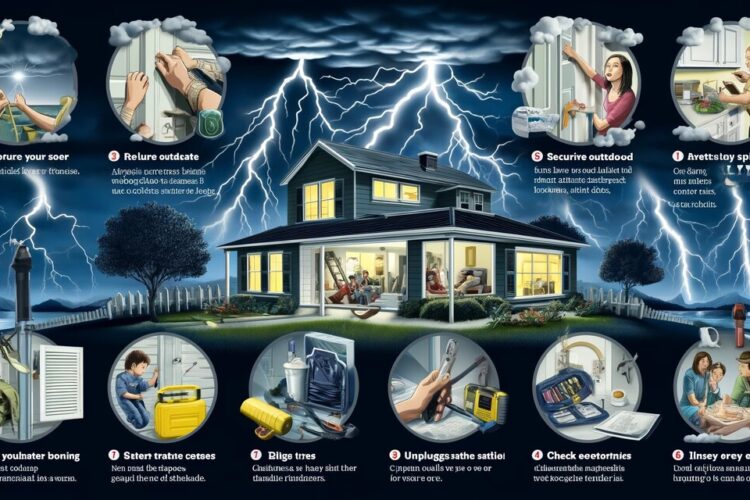Severe thunderstorms are powerful weather phenomena that can cause significant damage and pose serious threats to safety. When a severe thunderstorm warning is issued, it means that dangerous weather conditions are imminent, and it’s crucial to take immediate action to protect yourself and your loved ones. In this blog, we’ll explore what severe thunderstorms are, the dangers they present, how to stay informed, and steps to take to ensure your safety.
Understanding Severe Thunderstorms
Severe thunderstorms are storms that produce one or more of the following conditions:
- Hail with a diameter of at least one inch.
- Wind gusts of 58 miles per hour (93 km/h) or higher.
- Tornadoes.
These storms can develop rapidly and without much warning, making it essential to stay vigilant during severe weather conditions.
Characteristics of Severe Thunderstorms
- Hail: Hailstones can range from pea-sized to larger than golf balls. Large hailstones can cause significant damage to vehicles, roofs, windows, and crops. They can also pose a danger to people and animals caught outside during the storm.
- High Winds: Severe thunderstorms can produce extremely strong winds that can uproot trees, damage buildings, and create flying debris, which can be deadly. These winds are often straight-line winds, differing from the rotational winds of a tornado.
- Tornadoes: Some severe thunderstorms can spawn tornadoes, which are violently rotating columns of air extending from the storm to the ground. Tornadoes can cause catastrophic damage and are life-threatening.
The Dangers of Severe Thunderstorms
Severe thunderstorms pose several risks:
- Injury and Fatalities: High winds, flying debris, hail, and lightning can cause injuries or fatalities. Tornadoes, in particular, can be devastating, with the potential to level entire neighborhoods.
- Property Damage: Hail can damage vehicles, roofs, and windows. High winds can tear off roofs, uproot trees, and knock down power lines. Lightning strikes can cause fires and electrical damage.
- Power Outages: Severe storms can damage power lines and infrastructure, leading to widespread power outages. These outages can last for hours or even days, affecting communication, heating/cooling, and access to essential services.
- Flooding: Intense rainfall from severe thunderstorms can lead to flash flooding, which can occur with little warning and be extremely dangerous.
Staying Informed
Staying informed about weather conditions is the first step in preparing for a severe thunderstorm. Here’s how you can stay updated:
Weather Alerts
- Weather Apps: Many weather apps provide real-time updates and alerts for severe weather. Make sure to enable notifications for severe weather warnings.
- NOAA Weather Radio: A NOAA Weather Radio provides continuous broadcasts of weather information and emergency alerts. It’s a reliable source, especially if other communication methods fail.
- Local News: Local television and radio stations often provide updates on weather conditions and severe weather warnings. Tuning in during a storm can give you the latest information.
- Emergency Alerts: Many regions have emergency alert systems that send notifications to your phone about severe weather. Make sure your phone is set to receive these alerts.
Understanding Weather Warnings
- Severe Thunderstorm Watch: Indicates that conditions are favorable for severe thunderstorms to develop. Stay alert and be prepared to take action.
- Severe Thunderstorm Warning: Issued when a severe thunderstorm has been spotted or indicated by radar. Immediate action is necessary to protect life and property.
Preparing for a Severe Thunderstorm
Preparation can make a significant difference in your ability to stay safe during a severe thunderstorm. Here are steps you can take to prepare:
Before the Storm
- Create an Emergency Kit: Your emergency kit should include essentials such as water, non-perishable food, a flashlight, batteries, a first-aid kit, medications, and important documents. Make sure you have enough supplies to last at least 72 hours.
- Secure Outdoor Items: High winds can turn outdoor furniture, garden tools, and other items into dangerous projectiles. Secure or bring these items indoors before the storm hits.
- Trim Trees and Shrubs: Keeping trees and shrubs trimmed can reduce the risk of branches breaking off during high winds and causing damage.
- Protect Your Home: Consider installing storm shutters or reinforcing windows and doors to protect against hail and debris. Ensure your roof is in good condition to withstand high winds.
- Know Your Safe Place: Identify the safest place in your home to take shelter during a severe thunderstorm. This is usually an interior room on the lowest floor, away from windows and exterior walls. A basement or storm cellar is ideal if you have one.
During the Storm
- Take Shelter: When a severe thunderstorm warning is issued, immediately move to your designated safe place. Stay away from windows and doors.
- Stay Informed: Continue to monitor weather updates through your weather app, NOAA Weather Radio, or local news. Stay alert for any changes in the storm’s path or intensity.
- Avoid Electrical Appliances: Lightning can cause power surges. Avoid using electrical appliances and unplug sensitive electronics to prevent damage.
- Do Not Use Plumbing: Lightning can travel through plumbing, so avoid using sinks, showers, and bathtubs during the storm.
- Stay Indoors: Remain inside until the storm has completely passed. Avoid going outside to assess damage until it is safe to do so.
After the Storm
- Assess Damage Safely: Once the storm has passed, carefully assess your property for damage. Be cautious of downed power lines, broken glass, and other hazards.
- Check on Neighbors: If it is safe to do so, check on your neighbors, especially the elderly or those with disabilities, to ensure they are safe and have the help they need.
- Report Damage: Contact your insurance company to report any damage to your property. Take photos of the damage for documentation.
- Stay Informed: Continue to listen for updates from local authorities, as additional storms or severe weather conditions may follow.
Conclusion
Severe thunderstorms are powerful and potentially deadly weather events that require serious attention and immediate action. By staying informed and preparing in advance, you can significantly reduce the risks to yourself, your loved ones, and your property. Remember to create an emergency kit, secure your home, and identify a safe place to take shelter. During the storm, stay indoors, avoid using electrical appliances, and keep informed about weather updates. After the storm, assess damage safely and help those around you who may need assistance.
Taking these precautions can make a significant difference in your safety and well-being during a severe thunderstorm. Stay safe, stay prepared, and always heed severe thunderstorm warnings.



0 Comments